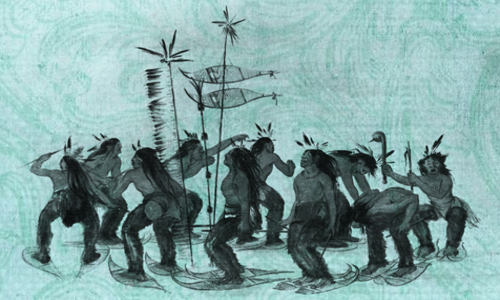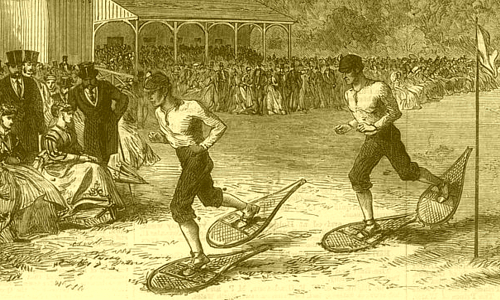A brief history of snowshoes

The origins of snowshoes are not precisely known, although historians believe they were invented from 4,000 to 6,000 years ago, probably in Central Asia, where the inhabitants of the Caucasus used to attach flat surfaces of leather under their feet. However, the "traditional" webbed snowshoe as we know it today had direct origins to North American indigenous people. In his travel memories Samuel de Champlain, referencing the Huron and Algonquin tribes, wrote: "Winter, when there is much snow, they make a kind of snowshoe that are two to three times larger than those in France, that they tie to their feet, and thus go on the snow, without sinking into it, otherwise they would not be able to hunt or go from one location to the other".
The indigenous people of North America developed the most advanced and diverse snowshoes prior to the 20th century. Nearly every tribe developed its own particular shape of shoe, the simplest and most primitive being those of the far North. The Inuit have two styles, one being triangular in shape and about 18 inches (46 centimeters) in length, and the other almost circular, both reflecting the need for high flotation in deep, loose and powdery snow. However, contrary to popular perception, the Inuit did not use their snowshoes much since they did most of their foot travel in winter over sea ice or on the tundra, where snow does not pile up deeply.
Southward the snowshoe becomes gradually narrower and longer, the largest being the hunting snowshoe of the Cree, which is nearly 6 feet (1.8 meters) long and turned up at the toe. Even smaller models, developed most notably by the Iroquois, are narrower and shorter, reflecting the need for maneuverability in forested areas. The Plains tribe members wore snowshoes on their winter season bison hunts before horses were introduced. Despite their great diversity in form, snowshoes were, in fact, one of the few cultural elements common to all tribes that lived where the winters were snowy.
Snowshoes were slowly adopted by Europeans in what became Canada and the United States, with the French voyageurs and coureur des bois well in advance of British settlers. French voyageurs were primarily 18th and 19th century French Canadian fur traders who explored the frontier waterways by canoe. Superior French snowshoeing skill almost turned the French and Indian War, a conflict that saw two engagements named “the Battle on Snowshoes”, to their favor. However, the British were quick learners. The Oxford English Dictionary reports the term being used by the English as early as 1674. Sixteen years later, after a French-Indian raiding party attacked a British settlement near what is today Schenectady, New York, the British took to their own snowshoes and pursued the attackers for almost 50 miles (80 kilometers), ultimately recovering both people and goods taken by their attackers.

Traditional snowshoes are made of a single strip of some tough wood, usually white ash, curved round and fastened together at the ends and supported in the middle by a light cross-bar, the space within the frame thus made being filled with a close webbing of dressed caribou or neat's hide strips, leaving a small opening just behind the cross-bar for the toe of the shoe. They are fastened to the shoe by leather thongs, sometimes by buckles.
The "teardrop" snowshoes worn by lumberjacks are about 40 inches (100 centimeters) long and broad in proportion, while the tracker's shoe is over 5 feet (150 centimeters) long and very narrow. This form, the stereotypical snowshoe, resembles a tennis racquet, and indeed the French term is raquette de neige. This form was copied by the Canadian snowshoe clubs of the late 18th century. Originally founded for military training purposes, these clubs became the earliest recreational users of snowshoes. The snowshoe clubs such as the Montreal Snow Shoe Club (1840) shortened the teardrop to about 40 inches (100 centimeters) long and 15 to 18 inches (380 to 460 millimeters) broad, slightly turned up at the toe and terminating in a kind of tail behind. This is made very light for racing purposes, but much stouter for touring or hunting. The tail keeps the shoe straight while walking. Another variant, the "bearpaw", ends in a curved heel instead of a tail. While many early enthusiasts found this more difficult to learn on, as they were thicker in the middle and rather cumbersome, they did have the advantage of being easier to pack and nimbler in tight spaces. Two forms of traditional bearpaw snowshoes developed; an eastern version used by "spruce gummers" consisting of an oval frame with wooden cross braces, and a western version with a rounded triangular frame and no wooden bracing. Snowshoe design didn't see significant change until the 1950's and the early development of the "Western" snowshoe. This style was generally smaller than the traditional wooden frames with a shorter tail section and greater upward angle in the toe area. Modified again in the 1970's with the availability of new materials, the "Western" style has become the snowshoe style of choice among modern day athletes. The use of lightweight aluminum frames and solid synthetic decking material has replaced the wooden frame and rawhide lacing of the past.
While recreational use of snowshoes began with snowshoe clubs in Quebec, Canada, the manufacture of snowshoes for recreational purposes really began in the late 19th century, when serious recreational use became more widespread.
Since September 7, 2007 - ©
Aerostato, Seattle - All Rights Reserved.
JOIN THE WORLDWIDE RUNNING NETWORK
5kCalendar.com |
AccidentalAthlete.com |
CalendarioTrail.it |
CorrereNelDeserto.com |
DeadRunnersSociety.com |
HalfMarathon.net |
ePodismo.com |
MarathonCoupons.com |
Maratone & Maratoneti |
OlympicGamesMarathon.com |
RoadRacingStats.com |
Run100Days.com |
RunningCalendar.com |
RunningInItaly.com |
TuttoMaratona.com |
Ultramaratona.it |
VerticalRunning.it |
WorldwideRunning.com

